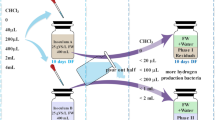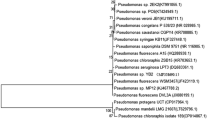Abstract
Batch and continuous mode degradation of monochloroacetic acid used as a sole carbon and energy source in the concentration range of 0.9–48.4 mM by pure culture of Xanthobacter autotrophicusGJ10 was investigated. The substrate was completely degraded in each flask in batch system. Partial substrate inhibition occurred at the concentrations exceeding 25.4 mM. Temporary accumulation of glycolic acid in the medium indicated that dehalogenation was undergoing faster than further utilization of glycolate. Three different carbon substrates were used for inoculum preparation – 1,2-dichloroethane, tri-sodium citrate and a nutrient broth. The fastest growth on monochloroacetate occurred for 1,2- dichloroethane-grown inoculum. The assays of haloacid dehalogenase in crude extract indicated that the bacteria grown on 1,2-dichloroethane possessed higher level of the enzyme. The response of the GJ10 culture towards spikes of 20 mM monochloroacetate was tested in 2.5-l continuously stirred tank fermentor. The substrate was readily utilized within 7–8 h. Continuous degradation of monochloroacetate in the fermentor was demonstrated for monochloroacetate concentration of 20 mM and dilution rate 0.016 h−1. Quantitative agreement between the amount of monochloroacetate introduced and chloride released was found. The results demonstrated that the strain X. autotrophicus GJ10 might be suitable for biodegradation of monochloroacetate contaminated media.
Similar content being viewed by others
References
JG Bergmann J Sanik (1957) ArticleTitleDetermination of trace amounts of chlorine in naphtha Anal. Chem. 29 241–243
MM Bradford (1976) ArticleTitleA rapid and sensitive method for the quantitation of microgram quantities of protein utilizing the principle of protein-dye binding Anal. Biochem. 72 248–254 Occurrence Handle10.1006/abio.1976.9999 Occurrence Handle1:CAS:528:DyaE28XksVehtrY%3D Occurrence Handle942051
DA Ellis ML Hanson PK Sibley T Shadid NA Fineberg KR Solomon DCG Muir SA Mabury (2001) ArticleTitleThe fate and persistence of trifluoroacetic and chloroacetic acids in pond waters Chemosphere 42 309–318
ML Hanson KR Solomon (2004) ArticleTitleHaloacetic acids in the aquatic environment. Part I: macrophyte toxicity Environ. Pollut. 130 371–383
DJ Hardman JH Slater (1981) ArticleTitleDehalogenases in soil bacteria J. Gen. Microbiol. 123 117–128
S Hashimoto T Azuma A Otsuki (1998) ArticleTitleDistribution, sources and stability of haloacetic acids in Tokyo Bay Jn. Environ. Sci. Technol. 17 798–805
U Heinze H-J Rehm (1993) ArticleTitleBiodegradation of dichloroacetic acid by entrapped and adsorptive immobilized Xanthobacter autotrophicus GJ10 Appl. Microbiol. Biotechnol. 40 158–164
DB Janssen A Scheper L Dijkhuizen B Witholt (1985) ArticleTitleDegradation of halogenated aliphatic compounds by Xanthobacter autotrophicus GJ10 Appl. Environ. Microbiol. 49 673–677
R Kern (1985) ArticleTitleProduction of drag reducing polymers by hydrogen bacteria Proc. Am. Inst. Phys. Conf. 137 135–142
R Kühn M Pattard (1990) ArticleTitleResults of the harmful effects of water pollutant to green algae (Scenedesmus suspiciatus) in the cell multiplication inhibition test Water Res. 24 31–38
LL Lifongo DJ Bowden P Brimblecombe (2004) ArticleTitlePhotodegradation of haloacetic acids in water Chemosphere 55 467–476
BM McRae TM LaPara RM Hozalski (2004) ArticleTitleBiodegradation of haloacetic acids by bacterial enrichment cultures. Chemosphere 55 915–925
M Meusel H-J Rehm (1993) ArticleTitleBiodegradation of dichloroacetic acid by freely suspended and adsorptive immobilized Xanthobacter autotrophicus GJ10 in soil Appl. Microbiol. Biotechnol. 40 165–171
AO Olaniran GO Babalola AI Okoh (2001) ArticleTitleAerobic dehalogenation potentials of four bacterial species isolated from soil and sewage sludge Chemosphere 45 45–50
MG Pervova VE Kirichenko KI Pashkevich (2002) ArticleTitleDetermination of chloroacetic acids in drinking water by reaction gas chromatography J. Anal. Chem. 57 326–330
S Reimann K Grob H Frank (1996) ArticleTitleChloroacetic acids in rainwater Environ. Sci. Technol. 30 2340–2344
A Römpp O Klemm W Fricke H Frank (2001) ArticleTitleHaloacetates in fog and rain Environ. Sci. Technol. 35 1294–1298
BF Scott D MacTavish C Spencer WMJ Strachan DCG Muir (2000) ArticleTitleHaloacetic acids in Canadian lake waters and precipitation Environ. Sci. Technol. 34 4266–4272
BF Scott C Spencer CH Marvin D MacTavish DGC Muir (2002) ArticleTitleDistribution of haloacetic acids in the water columns of the Laurentian Great Lakes and Lake Malawi Environ. Sci. Technol. 36 1893–1898
PC Uden JW Miller (1983) ArticleTitleChlorinated acids and chloral in drinking water J. Am. Water Works Assoc. 75 524–527
AJ Wijngaard Particlevan den KWHJ Kamp Particlevan der J Ploeg Particlevan der F Pries B Kazemier DB Janssen (1992) ArticleTitleDegradation of 1,2-dichloroethane by Ancylobacter aquaticus and other facultative metylotrophs Appl. Environ. Microbiol. 58 976–983
AJ Wijngaard Particlevan den RD Wind DB Janssen (1993) ArticleTitleKinetics of bacterial growth on chlorinated aliphatic compounds Appl. Environ. Microbiol. 59 2041–2048
J Ploeg Particlevan der DB Janssen (1995) ArticleTitleSequence analysis of the upstream region of dhlB, the gene encoding haloalkanoic dehalogenase of Xanthobacter autotrophicus GJ10 Biodegradation 6 257–263
J Ploeg Particlevan der M Willemsen G Hall Particlevan DB Janssen (1995) ArticleTitleAdaptation of Xanthobacter autotrophicus GJ10 to bromoacetate due to activation and mobilization of the haloacetate dehalogenase gene by insertion element IS1247 J. Bacteriol. 177 1348–1356
S Velizarov V Beschkov (1998) ArticleTitleBiotransformation of glucose to free gluconic acid by Gluconobacter oxydants: substrate and product inhibition situations Proc. Biochem. 33 527–534
L von Sydow H Borén A Grimvall (1999) ArticleTitleChloroacetates in snow, firn and glacier ice Chemosphere 39 2479–2488
RI Wilson SA Mabury (2000) ArticleTitleThe photodegradation metolachlor: isolation, identification, and quantification of monochloroacetic acid J. Agric. Food Chem. 48 944–950
FX Woolard RE Moore PP Roller (1979) ArticleTitleHalogenated acetic and acrylic acids from the Red alga Asparagopsis taxiformis Phytochemistry 18 617–620
Author information
Authors and Affiliations
Corresponding author
Rights and permissions
About this article
Cite this article
Torz, M., Beschkov, V. Biodegradation of monochloroacetic acid used as a sole carbon and energy source by Xanthobacter autotrophicus GJ10 strain in batch and continuous culture. Biodegradation 16, 423–433 (2005). https://doi.org/10.1007/s10532-004-3614-8
Accepted:
Issue Date:
DOI: https://doi.org/10.1007/s10532-004-3614-8




